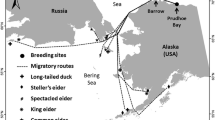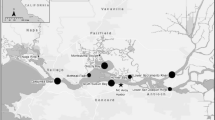Abstract
Our study determined if white-winged doves (WWDs; Zenaida asiatica asiatica) breeding in locations where environmentally persistent contaminants occur in the Lower Rio Grande Valley of Texas have levels of contaminants that can hinder reproduction. During summer 2003, 70 (32 males, 38 females) adult WWDs were collected from 8 at-risk sites. Liver tissues were analyzed for ten major and trace elements and muscle tissues were analyzed for 20 organochlorine compounds, 21 polychlorinated biphenyl congeners, and toxaphene. Samples were compared to ten (five male, five female) captive-raised control WWDs. Arsenic, chromium, and lead were not detected or were below the detection limit, whereas copper, zinc, selenium, mercury, nickel, cadmium, and silver were detected in 70 (100%), 70 (100%), 52 (74%), 21 (30%), 4 (6%), 1 (1%), and 1 (1%) WWDs, respectively. None of the detected elements had significant sampling site, bird gender, or Site × Gender interactions, and each occurred at background levels. Toxaphene and polychlorinated biphenyls were not detected, whereas DDE, dieldrin, γ-BHC, and chlordane were detected in 13 (19%), 5 (7%), 2 (3%), and 1 (1%) field-collected WWDs, respectively, but all concentrations occurred at background levels. Concentrations of elements and compounds in field-collected WWDs did not significantly differ from those of the controls. Correlations between leukocyte counts and detectable contaminants generally indicated no correlation between each percentage of leukocyte type present and levels of selenium, copper, zinc, mercury, or DDE detected. One sample that had 0.072 μg/g dieldrin exhibited a low lymphocyte percentage (66%) out of only five samples. Comparisons could not be made with γ-BHC, chlordane, or the other elements that had a low number of samples with detectable levels. Overall, concentrations of elements and organochlorines found in WWDs were below levels known to impair reproduction and survival in birds.

Similar content being viewed by others
References
Aengwanich W, Chinrasri O (2003) Effect of dexamethasone on differential white blood cell counts and heterophil/lymphocyte ratio in Japanese quails (Corurnix coturnix japonica). Songklanakarin J Sci Technol 25:183–189
Albrecht LJ (1994) Mystery in Cameron County Physicians and health officials search for cause of high rate of anencephaly in the Rio Grande Valley. Texas Med 90:16–18
Benson WW, Pharaoh B, Miller P (1974) Lead poisoning in a bird of prey. Bull Environ Contam Toxicol 11:105–108
Briggs KT, Gershwin ME, Anderson DW (1997) Consequences of petrochemical ingestion and stress on the immune system of seabirds. ICES J Mar Sci 54:718–725
Burger J, Woolfenden GE, Gochfeld M (1999) Metal contamination in the eggs of endangered Florida scrub-jays from central Florida. Arch Environ Contam Toxicol 37:385–388
Burkepile NA, Hewitt DG, Waggerman GL, Small MF, Hellgren EC (2002) Effects of methyl parathion on white-winged dove productivity and reproductive behavior. J Wildl Manage 66:202–211
Campbell TW (1994) Hematology. In: Ritchie BW, Harrison GJ, Harrison LR (eds) Avian medicine: principles and application. Wingers Publishing, Lake Worth, pp 176–198
Carrington ME, Mirarchi RE (1989) Effects of lead shot ingestion on free-ranging mourning doves. Bull Environ Contam Toxicol 43:173–179
Carter DE, Pena C, Varady R, Suk WA (1996) Environmental health and hazardous waste issues related to the U.S.-Mexico border. Environ Health Perspect 104:590–594
Chang PW, Sculco F, Yates VJ (1977) An in vivo and in vitro study of infectious laryngotracheitis virus in chicken leukocyctes. Avian Dis 21:492–500
Cobb GP, Wood PD, O’Quinn M (1997) Polychlorinated biphenyls in eggs and chorioallantoic membranes of American alligators (Alligator mississippiensis) from coastal South Carolina. Environ Toxicol Chem 16:1456–1462
Cottam C, Trefethen JB (1968) Whitewings: the life history, status and management of the white-winged dove. D. Van Nostrand Co., Princeton
Custer TW, Mitchell CA (1987) Exposure to insecticides of brushland wildlife within the Lower Rio Grande Valley, Texas, USA. Environ Pollut 45:207–220
Davis JR, Kleinsasser LJ, Cantu R, Saunders K (1994) Occurrence and impact of toxic chemicals in the Rio Grande and selected tributaries, Texas and Mexico. Texas Natural Resource Conservation Commission Research and Environmental Assessment Section, San Marcos
DeMent SH, Chisolm JJ, Eckhaus MA, Strandberg JD (1987) Toxic lead exposure in the urban rock dove. J Wildl Dis 23:273–278
Eisler R (1985) Cadmium hazards to fish, wildlife and invertebrates: a synoptic review. US Dept Inter Biol Rep 85(1.2):30
Eisler R (1996) Silver hazards to fish, wildlife and invertebrates: a synoptic review. US Dep Inter Biol Rep 32:63
Fontenot LW, Noblet GP, Akins JM, Stephens MD, Cobb GP (2000) Bioaccumulation of polychlorinated biphenyls in ranid frogs and northern water snakes from a hazardous waste site and a contaminated watershed. Chemosphere 40:803–809
George RR, Tomlinson RE, Engel-Wilson RW, Waggerman GL, Spratt AG (1994) White-winged dove. In: Tacha TC, Braun CE (eds) Migratory shore and upland game bird management in North America, 2nd edn. The International Association of Fish and Wildlife Agencies, Washington, DC, pp 29–50
Haegele MA, Hudson RH (1973) DDE effects on reproduction of ringed doves. Environ Pollut 4:53–57
Heisel DR (1990) Less than obvious: statistical treatment of data below the detection limit. Environ Sci Technol 24:1766–1774
Hutton M, Goodman GT (1980) Metal contamination of feral pigeons Columba livia from the London area: Part 1. Tissue accumulation of lead cadmium and zinc. Environ Pollut 22:207–217
Kiel WH Jr, Harris JT (1956) Status of the white-winged dove in Texas. Trans North Am Wildl Nat Res Conf 21:376–389
King KA, Cromartie E (1986) Mercury, cadmium, lead, and selenium in three waterbird species nesting in Galveston Bay, Texas, USA. Colonial Waterbirds 9:90–94
King KA, Custer TW, Quinn JS (1991) Effects of mercury, selenium, and organochlorine contaminants on reproduction of Forster’s terns and black skimmers nesting in a contaminated Texas bay. Arch Environ Contam Toxicol 20:32–40
Marsh EGJ, Saunders GB (1942) The status of the white-winged dove in Texas. Wilson Bull 54:145–146
Matthews SL, McCracken IR, Lonergan G (1995) Mercury contamination of golf courses due to pesticide use. Bull Environ Contam Toxicol 55:390–397
McDonald, S (2005) Complete blood count. http://wwww.parrottalk.com/cbc.html. Accessed 14 Oct 2005
Michot TC, Custer TW, Nault AJ, Mitchell CA (1994) Environmental contaminants in redheads wintering in coastal Louisiana and Texas. Arch Environ Contam Toxicol 26:425–434
Mirarchi RE (1993) Care and propagation of captive mourning doves. In: Baskett TS, Sayre MW, Tomlinson RE, Mirarchi RE (eds) Ecology and management of the mourning dove. Stackpole Books, Harrisburg, pp 409–428
Mora MA (1995) Residues and trends of organochlorine pesticide and polychlorinated biphenyls in birds from Texas 1965–1988. US Department Interior, National Biological Service Fish Wildlife Research 14, Washington, DC
Mora MA (1996) Organochlorines and trace elements in four colonial waterbird species nesting in the Lower Laguna Madre, Texas. Arch Environ Contam Toxicol 31:533–537
Mora MA, Anderson DW (1995) Selenium, boron, and heavy metals in birds from the Mexicali Valley, Baja California, Mexico. Bull Environ Contam Toxicol 54:198–206
Mora MA, Lee MC, Jenny JP, Schultz TW, Sericano JL, Clum NJ (1997) Potential effects of environmental contaminants on recovery of the aplomado falcon in south Texas. J Wildl Manage 61:1288–1296
Moura MA, Machado CH, Porfirio LC, Freire RB (2004) Effects of ochratoxin on broiler leukocytes. Rev Bras Ciene Avic 6:1–7
Ohlendorf HM, Lowe RW, Kelly PR, Harvey TE (1986) Selenium and heavy metals in San Francisco Bay diving ducks. J Wildl Manage 50:64–71
Olsgard ML (2007) Toxicological evaluation of inhalation exposure to benzene and toluene in a raptorial bird, the American kestrel, Falco sparverius. Master thesis, University of Saskatchewan, Saskatoon, Canada
Outridge PM, Scheuhammer AM (1993) Bioaccumulation and toxicology of chromium: implications for wildlife. Rev Environ Contam Toxicol 130:31–77
Owen JC, Moore FR (2006) Seasonal differences in immunological condition of three species of thrushes. Condor 108:389–398
Pais I, Jones JB Jr (1997) Trace elements. The handbook of trace elements. St. Lucie Press, Boca Raton
Pastoret P-P, Griebel P, Bazin H, Govaerts A (1998) Handbook of vertebrate immunology. Academic Press, San Diego
Pendleton GW, Whitworth MR, Olsen GH (1995) Accumulation and loss of arsenic and boron, alone and in combination, in mallard ducks. Environ Toxicol Chem 14:1357–1364
Prasada Rao PVV, Jordan SA, Bhatnagar MK (1989) Combined nephrotoxicity of methylmercury, lead, and cadmium in pekin ducks: metallothionein, metal interactions, and histopathology. J Toxicol Environ Health 26:327–348
Rollins-Smith LA, Rice CD, Grasman KA (2007) Amphibian, fish and bird immunotoxicology. In: Luebke R, House R, Kimber I (eds) Immunotoxicology and immunopharmacology, 3rd edn. CRC Press/Taylor and Francis Group, Boca Raton
Schwarzbach SE, Shull L, Grau CR (1988) Eggshell thinning in ring doves exposed to p,p′-Dicofol. Arch Environ Contam Toxicol 17:219–227
Small MF, Waggerman GL (1999) Geographic redistribution of breeding white-winged doves in the Lower Rio Grande Valley of Texas: 1976–1997. Tex J Sci 51:15–19
Small MF, Pruett CL, Hewitt DG, Hellgren EC, Perrigo GH, Waggerman GL (1998) Cholinesterase activity in white-winged doves exposed to methyl parathion. J Wildl Dis 34:698–703
Smith PN, Cobb GP, Harper FM, Adair BM, McMurry ST (2002) Comparison of white-footed mice and rice rats as biomonitors of polychlorinated biphenyl and metal contamination. Environ Pollut 119:261–268
Swanson DA, Rappole JH (1992) Status of the white-winged dove in southern Texas. Southwest Nat 37:93–97
Tacha TC, Schacht SJ, George RR, Hill EF (1994) Anticholinesterase exposure of white-winged doves breeding in Lower Rio Grande Valley, Texas. J Wildl Manage 58:213–217
Texas Department of Health (2001) Locations by county for advisories and bans. http://www.tdh.state.tx.us/bfds/ssd/fiscount.html. Accessed 6 Sep 2001
Texas Parks and Wildlife Department (2008) Wildlife fact sheets. http://www.tpwd.state.tx.us/huntwild/wild/species/. Accessed 10 Nov 2008
Wainwright SE (1998) Screening for environmental contaminants and endocrine disruption in wildlife from the Lower Rio Grande Valley, Texas: an ecological and biomarker approach. MS thesis, Texas A&M University, College Station, TX
Wainwright SE, Mora MA, Sericano JL P, Thomas P (2001) Chlorinated hydrocarbons and biomarkers of exposure in wading birds and fish of the Lower Rio Grande Valley, Texas. Arch Environ Contam Toxicol 40:101–111
Wallach JD, Cooper JE (1982) Nutritional diseases of wild birds. In: Hoff GL, Davis JW (eds) Noninfectious diseases of wildlife. Iowa State University Press, Ames, pp 113–126
White DH, King KA, Prouty RM (1980) Significance of organochlorine and heavy metal residues in wintering shorebirds at Corpus Christi, Texas, 1976–77. Pestic Monit J 14:58–63
White DH, Mitchell CA, Kennedy HD, Krynitsky AJ, Ribick MA (1983) Elevated DDE and toxaphene residues in fishes and birds reflect local contamination in the Lower Rio Grande Valley, Texas. Southwest Nat 28:325–333
Zinkl JG (1986) Avian hematology. In: Jain NC (ed) Schalm’s veterinary hematology, 2nd edn. Lea & Febiger, Philadelphia, pp 256–260
Acknowledgments
Funding for this research was provided by the Texas Parks and Wildlife Department with proceeds from the white-winged dove hunting stamp. The authors thank Jaclyn Canas, Ed Scollon, George Cobb, and Gopal Coimbatore for assistance with analytical method development and elements analyses. This is manuscript No. 08-125 of the Caesar Kleberg Wildlife Research Institute.
The views expressed in this document are those of the authors and do not necessarily reflect the view of the US Fish and Wildlife Service. Mention or use of any trademarked products is not to be considered an endorsement of such by the US Fish and Wildlife Service.
Author information
Authors and Affiliations
Corresponding author
Rights and permissions
About this article
Cite this article
Fredricks, T.B., Fedynich, A.M., Benn, S. et al. Environmental Contaminants in White-Winged Doves (Zenaida asiatica asiatica) from the Lower Rio Grande Valley of Texas, USA. Arch Environ Contam Toxicol 57, 387–396 (2009). https://doi.org/10.1007/s00244-008-9274-7
Received:
Accepted:
Published:
Issue Date:
DOI: https://doi.org/10.1007/s00244-008-9274-7




